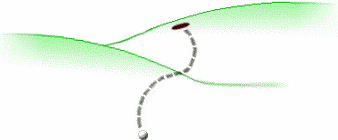Golf Instruction Article
|
|||||
How to Read Greens
|
|
Work on your game in person with the author of this article and website at Located in the east bay area of San Francisco Or if that's not possible get the author's 4-volume series of paperback books, covering the entire game in detail. |
Okay, so you look at the ground between your ball and the hole, see which way any slope (obvious or subtle) leans and get a sense of how the ball will roll on its way to the hole. There you go; you've just read the green.
It's such a subjective thing, learned from experience, that it's hard to describe it much further than that. I've had beginning students taking their first putting lesson that could not see any but the most severe slopes on greens. Once you have hit your first putt and seen it break you begin to tune into things on a more subtle level, and the more time and experience you have putting on greens the more developed your ability to read them gets.
If you can see and balance (keep yourself upright) you can probably read greens. All we're really talking about is being able to see variations from perfectly level (and factoring in a few nuances). If you feel that you're hopelessly out of touch with this ability take comfort from the fact that at least you have enough of it to keep yourself from falling over when you're standing or walking (I hope). Just know that virtually everybody who can see and stand has the ability to read putts -- it can be developed. Start putting and reading (or trying to read) all your putts and eventually it will come.
What is reading the green or putt?
Reading a green or putt is imagining, visualizing, picturing, guessing, or foreseeing the line/path on which the ball will roll once struck. Some putts will be straight, but most of them will break -- some very slightly and some enormously.
Why do you read putts?
To get a sense of how the putt is going to curve (break) so that you can hit the ball in the right direction to have it end up in the hole, or close. Reading the green will give you the visual information you need to get the ball started in the right direction to compensate for whatever break there is.
|
How about plumb bobbing? You know, when you see players hold their putter hanging down in front of their faces, looking all serious and scientific? Plumb bobbing would work in theory, in controlled conditions, with only one plane or slope. But since that will never happen and there are so many other factors influencing the break of putts plumb bobbing is only valuable if it helps a player focus (for instance, when you see players cup their hands around their eyes to block out light and/or distractions in their peripheral view). Most players that plumb bob just do it out of habit. It's more of a pre-shot routine mannerism than anything that actually figures in the calculation of the break. And even if it helps suggest the general break it is vague on the order of saying that the sun rises in the east. |
What factors go into reading a putt?
Judging a putt is a combination of speed (how fast or slow the ball will roll and, therefore, how far it will travel) and line (direction). Gravity and friction act on the ball over time, so the more slowly the ball rolls the more it will break and vice versa.
What factors affect speed and line?
- Slope
- Grass length
- Moisture level in, and on, the grass
- Base (firmness of green)
- Wind
- Grain (mainly on coarse-bladed grasses) Note: Some strains of grass have grain (blades growing in the same direction) that effects the way the ball rolls. This is becoming much less of an issue with newer and
better strains of grass that hold up well in hotter climates. Some general help with grain:
- it mainly effects the ball as the ball slows down
- the ball will be influenced in the direction that the grain grows
- it usually grows toward the setting sun or toward the closest body of water
- you can usually see the grain either by the shininess of the grass (shiny = grain is going away from you; dull = grain is coming toward you) or by looking at the cup (the brown or rough looking side of the cup is the down-grain side)
Things that will help:
(Do these things as thoroughly as you like and at your leisure while practicing. But, of course, don't do all these things on every putt during a round of golf -- keep pace of play
in mind.)
- Get your eyes down lower (that's why everybody is squatting down to read the putts -- the closer your eyes get to the level of the plane you're trying to see the better your perspective). An extreme version of this would be lying down (don't do this when you're playing, but I've seen it done and have done it myself in practice just to see what it's like).
- Get any information you can from approaching chips and putts -- yours or those of the other players in your group -- especially if they are on a similar line to the putt you will hit next. It's especially good to see how the ball behaves as it slows down and gets very near the hole.
- Look from the low side of the hole. This is just another way of getting your eyes lower. Of course, this only works on putts where you can tell which side is the low side.
- Get far enough away from what you're looking at to give yourself a good angle or perspective. A good place to start, at least on shorter putts, is to get back as far away from the ball as the ball is from the hole.
- Take a look from the side of the putting line (approximately perpendicular to the intended line of the putt). This helps you to see if the putt is uphill or downhill.
- Imagine pouring a bucket of water on the green between your ball and the hole, which way would the water run?
Of course, all of this assumes that your putting technique is good. Putting and short game technique are covered in detail in my book, The Short Game.
Judging the speed and line of your putts can be obvious or very subtle from putt to putt. But with a little time and experience and lots of trial and error anybody can develop the ability to read greens. It's an art, in the end, but nothing that focusing your attention won't get you.
P.S. Once you have read the putt you can use the information in my previous instruction article, "Using an Intermediate Target," to get lined up accurately.




